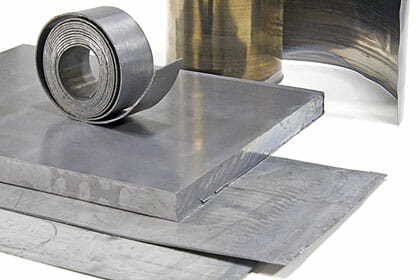
Nuclead has extensive experience shipping Lead sheet, please click here for more information on our lead sheet experience
Lead Sheet
Lead Sheet has multiple uses, including radiation shielding, nuclear shielding, tank linings, lead flashing, sound-proofing, vibration absorbers, x-ray shielding, lead gaskets, , lead ballast, and corrosion resistance lining.
Additional Lead Sheet applications information can be found at this link
Lead Alloy Sheets
Because lead is very soft and ductile, it is often used commercially as lead alloys. Lead-Antimony and Lead-Tin are common alloys.
Antimony generally is used to give greater hardness and strength to lead sheets and lead plates used for applications like storage battery grids. Antimony contents of lead-antimony alloys can range from 0.5 to 25%, but they are usually 2 to 5%.
Adding tin to lead or lead alloys increases hardness and strength, but lead-tin alloys are more commonly used for their good melting, casting, and wetting properties, as in type metals and lead solders. Lead-Tin forms the principal ingredients of many low-melting lead alloys.
Lead Foil
What is lead foil? Lead Foil, is a form of lead sheet that is thin enough to be easily cut and formed using shears. Lead foil can be stamped or formed into almost any shape so that it can be placed around any area that needs protection. Lead foil is often supplied backed with pressure sensitive adhesive or vinyl to aid the application of the product.
Lead Soundproofing
Lead sheet is quite effective as a soundproofing material. Lead sheets provide effect noise absorption, being over 10 times more absorbent than glass or concrete and up to a 100 times more absorbent than wood.
Additional lead soundproofing information can be found by clicking this link
| Lead for Noise Control: Lead verses other materials (approximate thickness required in inches) |
|||
|---|---|---|---|
| Material | Moderately Noisy Office | Quiet Office | Very Quite Office |
| Fir Plywood | 3.67″ | 6.67″ | 13.33″ |
| Sand Plaster | 0.2″” | 4.45″ | 8.9″ |
| Glass | 0.13″ | NA | 9.3″ |
| Dense Concrete | 0.14″ | 4.85″ | 12.2″ |
| Aluminum | 0.13″ | 5.7″ | 11.3″ |
| Steel | 0.045″ | NA | 7″ |
| Lead | 0.03″ | 0.135″ | 0.54″ |
Lead Shielding
Lead Shielding refers to the use of lead as a form of radiation protection to shield people or objects from radiation. Lead sheets can be used to effectively attenuate certain kinds of radiation because of leads high density and high atomic number. Lead sheet is very effective at stopping alpha rays, gamma rays, and x-rays. Lead sheet is only somewhat effective for neutron radiation.
Lead sheet is used for x-ray shielding and nuclear shielding at power plants, labs, and military installations.
| X-Rays generated by peak voltages not exceeding | Minimum thickness of Lead | Weight per Square Foot in Pounds | |
|---|---|---|---|
| Millimeters (mm) | Inches | ||
| 75 kV | 1 | 0.039 | 2.5 |
| 100 kV | 1.5 | 0.059 | 4 |
| 125 kV | 2 | 0.079 | 5 |
| 150 kV | 2.5 | 0.098 | 7 |
| 175 kV | 3 | 0.118 | 8 |
| 200 kV | 4 | 0.157 | 10 |
| 225 kV | 5 | 0.197 | 13 |
| 300 kV | 9 | 0.354 | 24 |
| 400 kV | 15 | 0.591 | 38 |
| 500 kV | 22 | 0.369 | 56 |
| 600 kV | 34 | 1.343 | 81 |
| 900 kV | 51 | 2 | 120 |
For a complete listing of products available on this site, go to the products and services index page